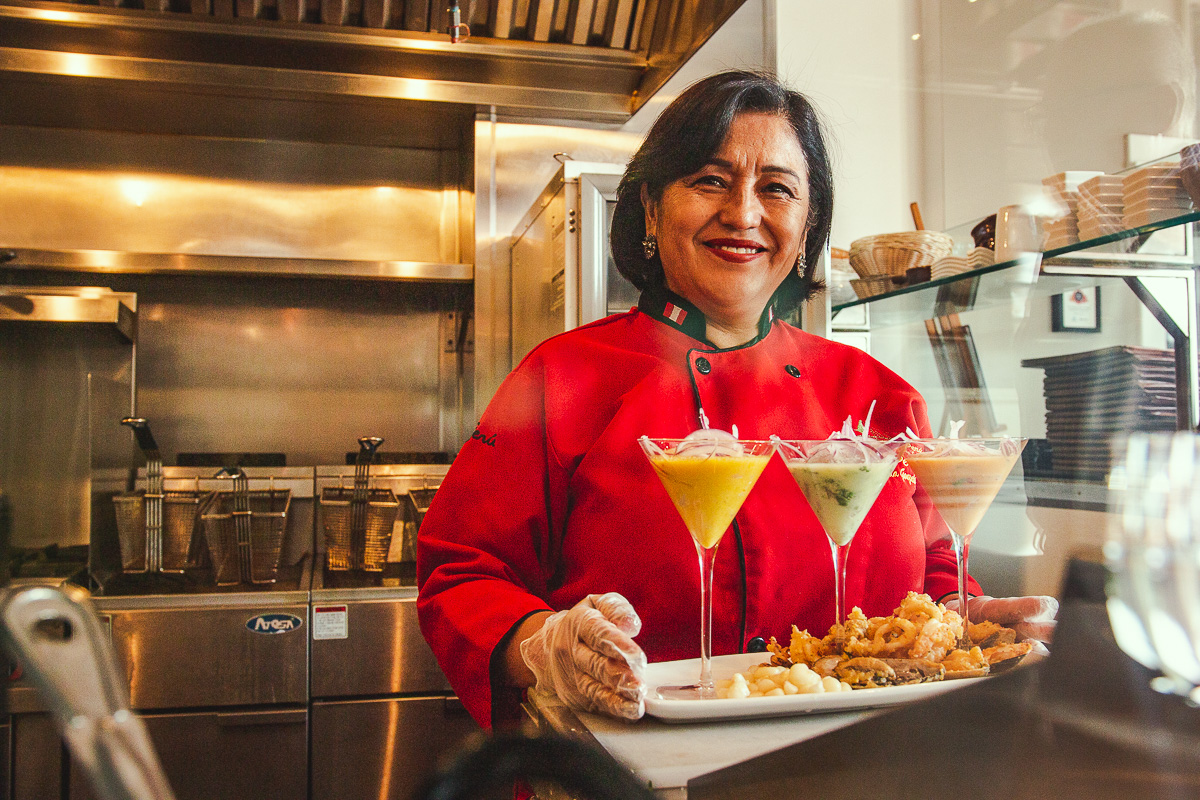
A food and travel riddle: what nation’s cuisine is consistently ranked as among the finest in the world yet largely unknown to most Americans?
Hint: it is in our own backyard — relatively speaking.
If you knew the answer, before reading the headline, you deserve an alfajores.
Yes, ¡Peru! That kidney bean-shaped South American country, squeezed between the South Pacific and Brazil, is widely considered one of the culinary capitals of the western world.
Our southern neighbor, with a population about the size of Texas, was awarded the 2019 designation: “World’s Leading Culinary Destination” by an international jury of food experts from the travel industry. And not for the first time: Peru has earned that distinction for 8 of the past 10 years.
Foodies in this country are catching on. While there was but a handful of Peruvian eateries in most U.S. cities just a decade ago, the news is out, and the number of restaurants serving Peruvian food has grown substantially.
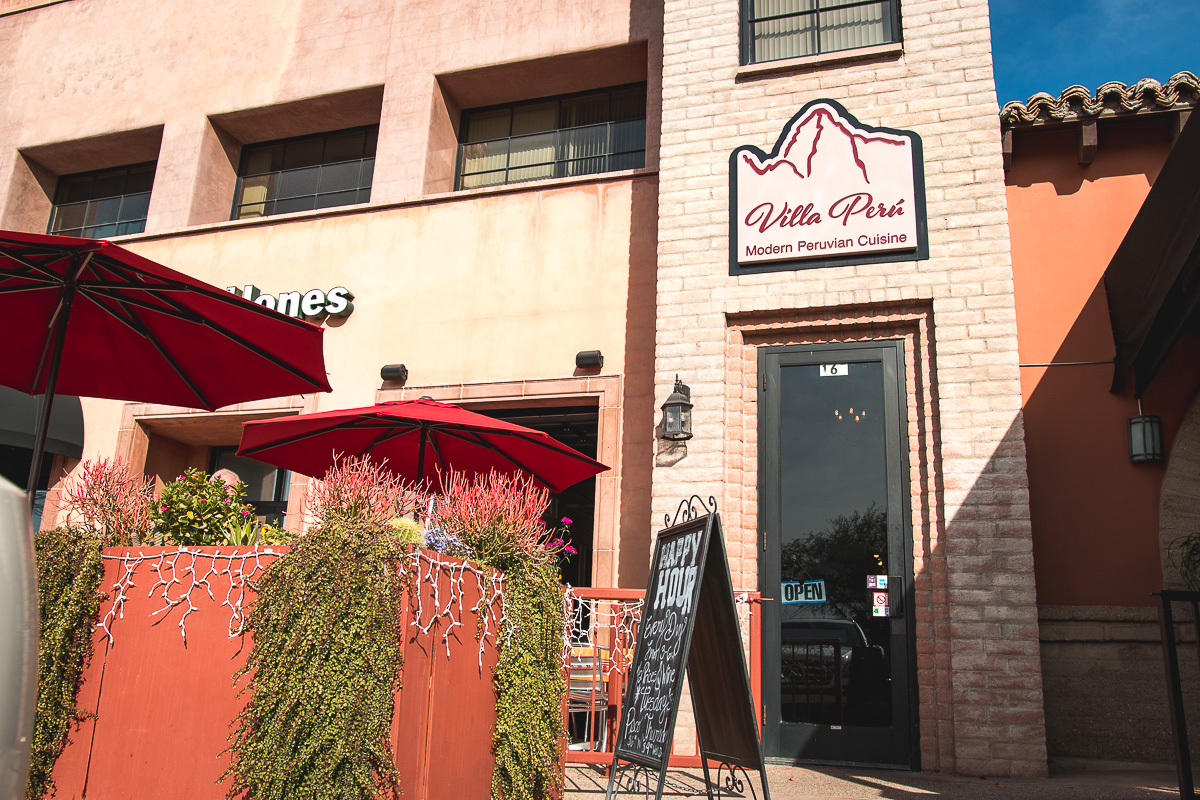
So, it should not be surprising that Tucson, known as a city serious about its food and as an important U.S. gateway to Latin America, is fortunate to have a gourmet Peruvian restaurant.
Word is out about Villa Peru: Modern Peruvian Cuisine. Whether it concerns their periodic ceviche or pachamanca festivals, their happy hour specials (drinks and appetizers $7 or less), or their Peruvian Independence Day celebrations (in late July), this elegant, two-year-old restaurant has already become a popular Tucson destination.
Villa Peru, owned and operated by an extended Peruvian family, is dedicated to serving celebrated, traditional Peruvian food to discerning southern Arizona gourmands — both to those simply curious about this acclaimed but unfamiliar cuisine, as well as fervent, returning devotees.
Finding Villa Peru may require some navigational skills. Located in the Joesler Village shopping complex — northwest corner of East River Road and North Campbell Avenue — the restaurant’s front entrance is not prominent or easy to spot, even with GPS in hand.
Hungry explorers — heading east to west — must first pass Zinburger, P.F. Chang’s, Sullivans, and Seis Kitchen just to discover the doorway to Villa Peru. Fortunately, such searches are amply rewarded by a multitude of awaiting tasting treasures.

The restaurant’s long, narrow interior space brings to mind a map of Peru, which stretches from Colombia (north) to Chile (south), with the majestic Andes Mountains running along the country’s eastern border with Brazil and Bolivia. The Villa Peru dining room is a delight — artistically designed and decorated, warm and intimate.
Guests are likely to encounter a member of the Villa Peru family — the Salazars and Hunts, who own and run the restaurant. Walter Salazar, el patriarch, is executive chef, and his wife, Frida, is the designated sous chef. Their daughters, Frida Hunt, Villa Peru’s general manager, and Magda Salazar, are also restaurant co-owners, and one may also encounter their brother, employee Mauricio Salazar, or Frida Hunt’s husband, Charles, business manager.
Frida Hunt, the face of the restaurant to most patrons, seems to be everywhere — greeting guests, assisting wait staff, overseeing operations, and advising patrons. Since many of her new customers have not sampled Peruvian food before, she happily offers introductions and recommendations.
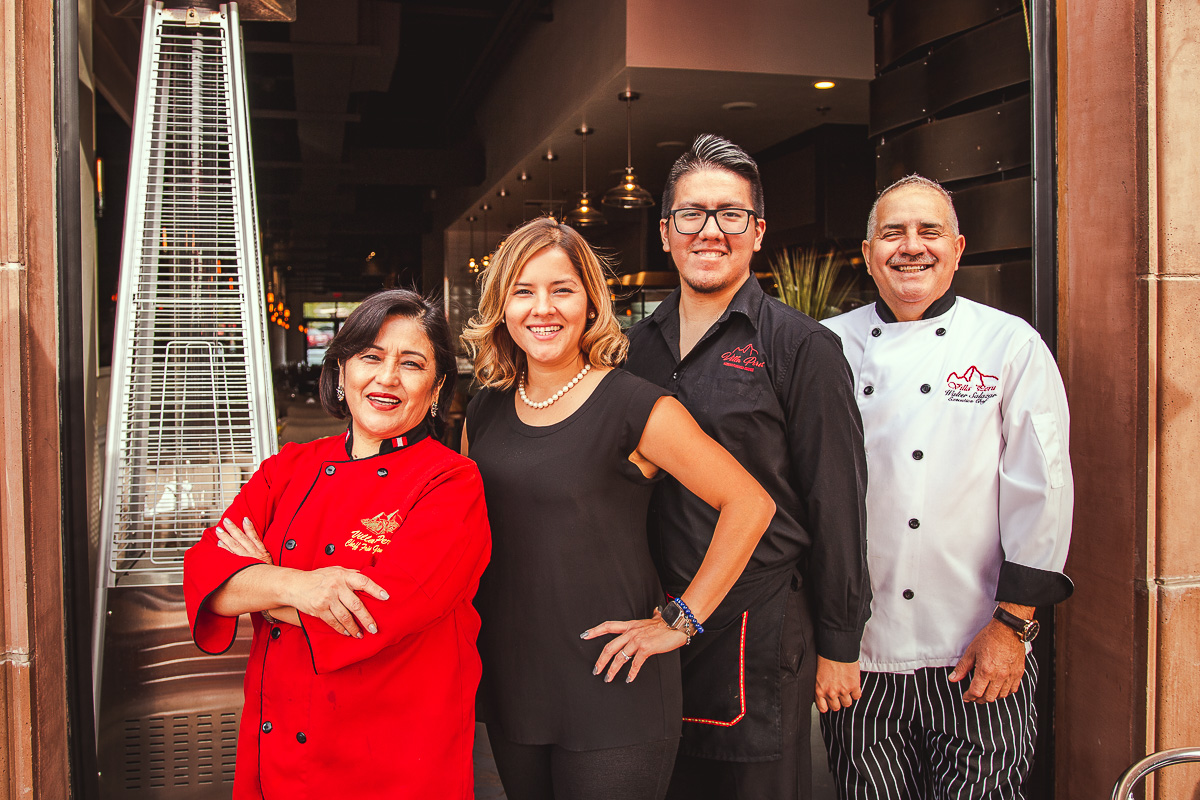
Her hours at the restaurant, are often long, and the Hunts have two young children, but, Frida is quick to offer, “This is a happy adventure for our entire family; Villa Peru is our dream.”
An appropriate introduction to Peru-in-Tucson might be sampling the country’s signature cocktail — often called its “national drink” — the pisco sour.
A type of brandy, pisco is made with distilled, fermented white grape wine. But more so than most other wine, pisco packs a real punch. Mildly sweet and fruity on the tongue, this exalted spirit has a relatively high alcohol content — 60 to 100 proof, depending on the variety.
According to legend, pisco was developed by 16th-century Spanish settlers, frustrated by the difficulty of importing brandy from home. After much tinkering, these thirsty transplants concocted a beverage unique among the world’s fine spirits.
Peruvian lore suggests that, while Spanish vintners distilled the brandy, it was an American bartender, Victor Morris, who first modified the traditional whiskey sour by substituting pisco for bourbon.
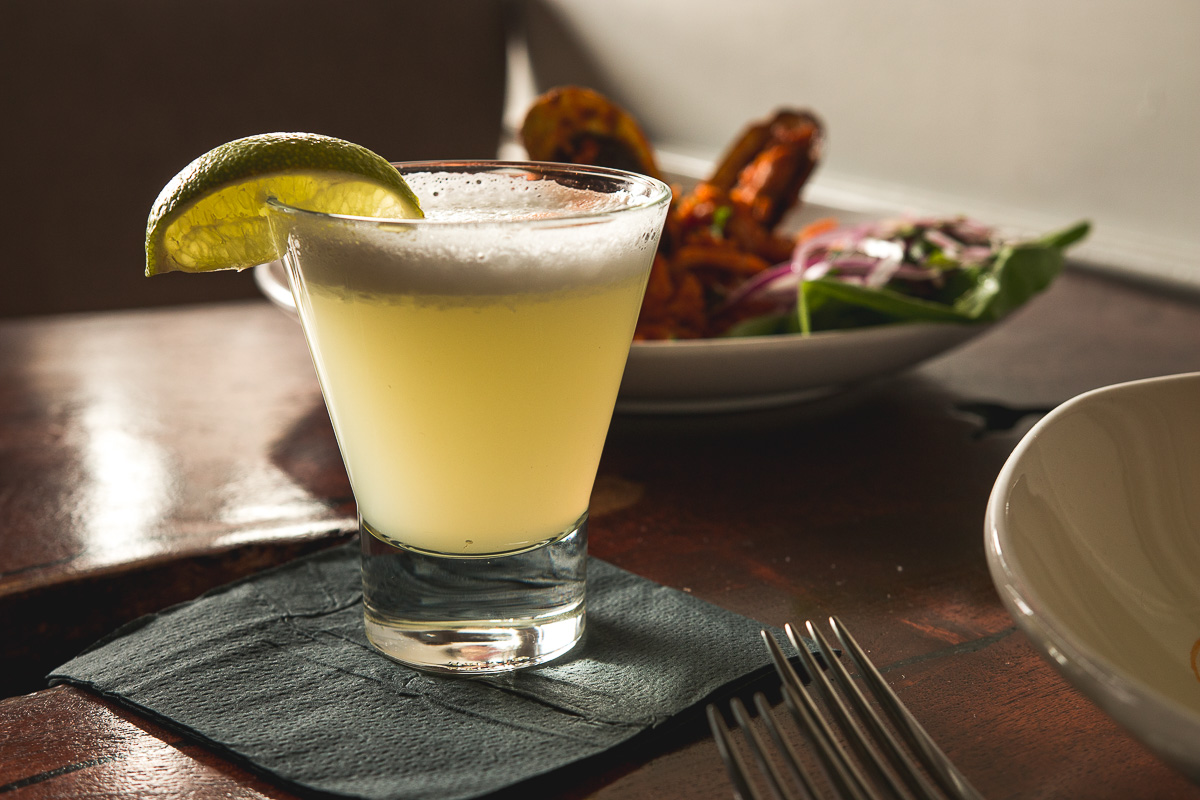
Working at a tavern in Lima — Peru’s capital and largest city — Morris experimented by pairing pisco with citrus juice, simple syrup, and a bit of egg white, producing an extraordinary cocktail: mellow, mildly sweet, yet tangy, with a definite kick. It was an instant success and has remained so.
A visitor is likely to spot Villa Peru’s pisco sours — $7 during Happy Hour (3 – 6 p.m. Monday through Saturday) and $6 on the restaurant’s weekly “Pisco Thursdays” — served throughout the restaurant, from its front, outdoor patio to the cozy bar in the back.
Those who prefer non-alcoholic drinks are encouraged to try Chicha Morada, a light beverage more popular in Peru than Coca-Cola. Curiously, the base of this soft drink is purple corn, which is boiled with pineapple and quince, with an added pinch of cinnamon and cloves. High in antioxidants, some Peruvians consider the dark red chicha morada a health tonic. If so, it is certainly among the most delicious medicines on the market.
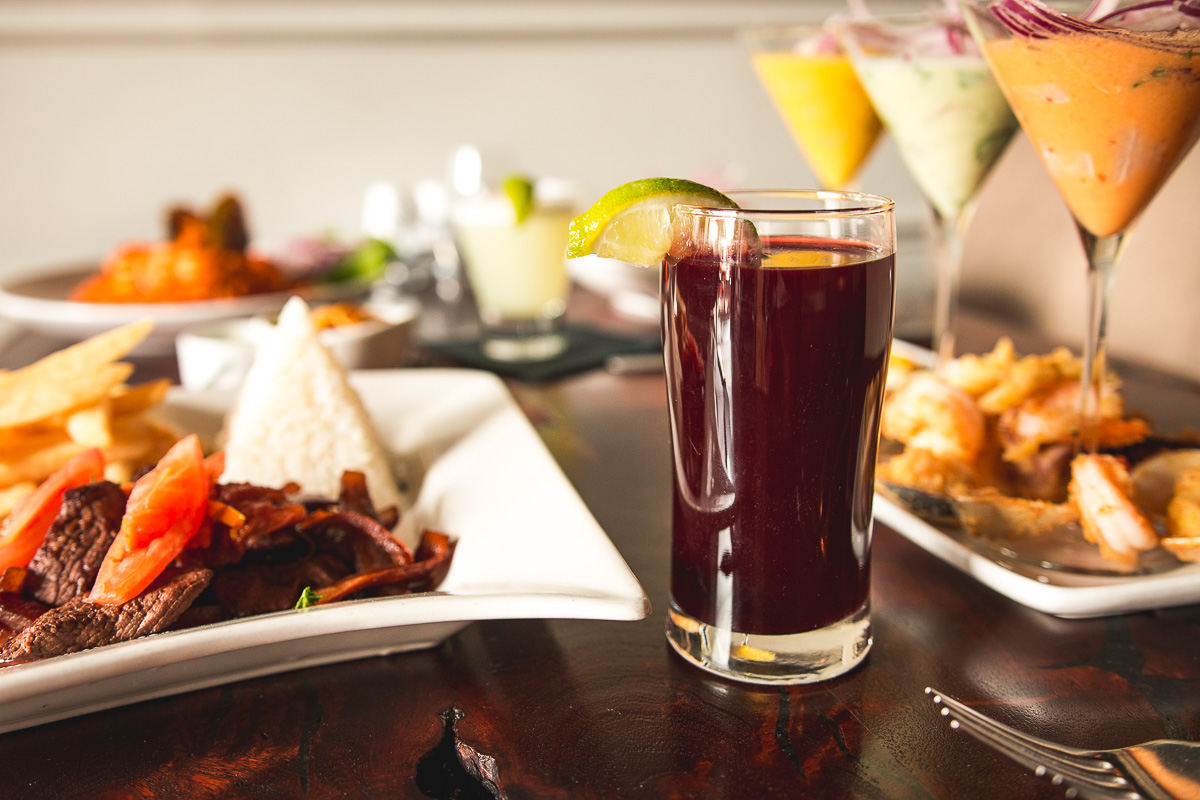
Cocktails call for salty bar snacks, and those provided at Villa Peru are crispy and savory. Served with a pisco sour is a bowl of Cancha Salada — a Peruvian variety of corn nuts, made with large-kernel “choclo” corn, fried in oil and lightly salted. These round, orange, crunchy snacks should be delivered with the warning: “Can be addictive.”
Added to the bar offerings are crispy plantain chips, which virtually scream to be dipped in the complimentary Aji Verde — a truly exquisite, homemade, spicy, cilantro-based Peruvian condiment so delicious that guests are known to purchase containers to take home.
While consuming such exceptional munchies throughout a full evening may be tempting, an expansive menu of Peruvian appetizers, salads, small platters, sandwiches, soups, entrees, and desserts awaits.
If pisco is Peru’s most popular alcoholic drink, ceviche is, without question, the country’s best-known food. While Tucsonans are familiar with Mexican-style ceviche, this plato celebrado, was actually born in pre-Columbian Peru, hundreds of years before its export throughout South and North America, then Europe and Asia, and, eventually, the world.
Ceviche is raw fish bathed in slightly tart, palate-pleasing seasoning. Unlike sushi, ceviche’s fish — of multiple varieties — is marinated in lime juice, where it is cured (or, as some have described it, “cold-cooked”) by the limes’ citric acid. The ingredients in this fresh, healthy marinade include cilantro, onions, and a variety of Peruvian chilies, peppers, and other spices.
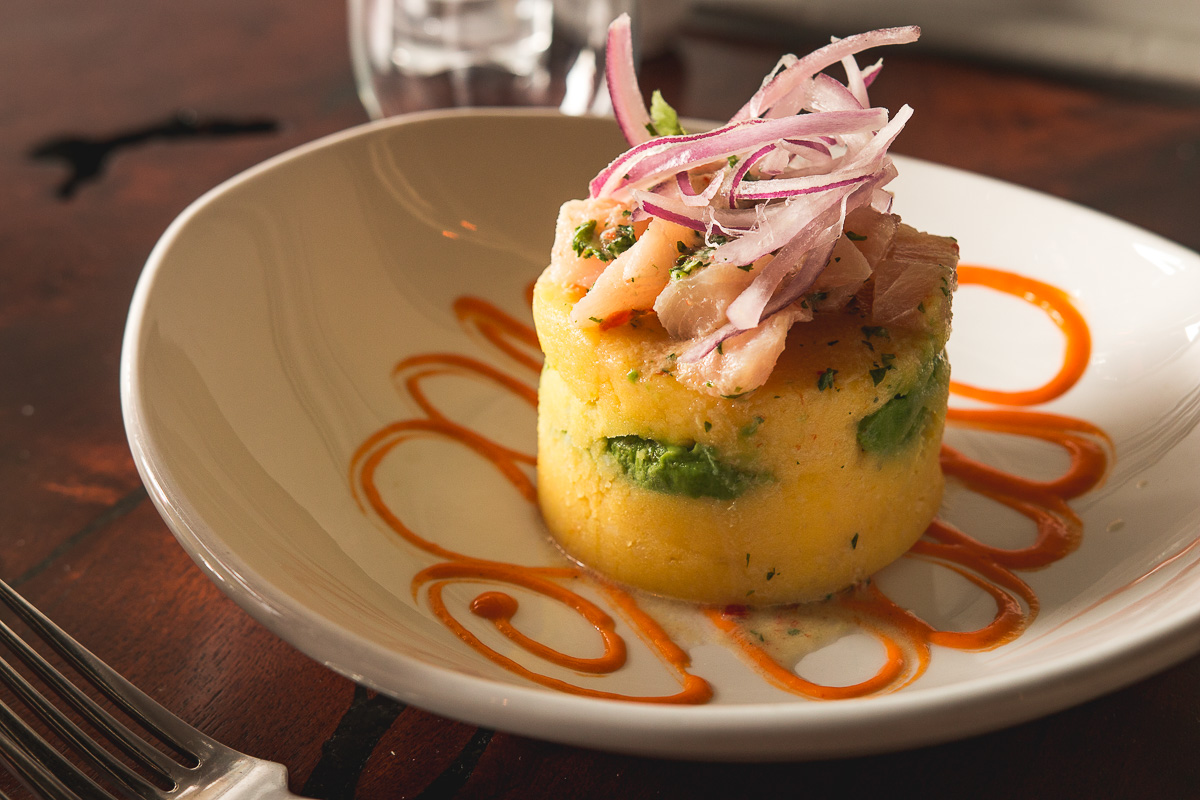
One restaurant appetizer favored by Villa Peru guests is Causa Acevichada — a colorful dish of lemony, whipped yellow potatoes imbued with “leche de tigre” (tiger’s’milk in English — the sobriquet Peruvians have given to ceviche’s zesty sauce), and topped with sliced avocado and artfully presented threads of fresh, red onions.
The presentation of the Causa Acevichada, like that of so many Villa Peru dishes, features brilliant colors of meticulously stratified goodness.
It should not be surprising that fish is a staple of most Peruvians’ diets. The country has 1,500 miles of Pacific coastline — nearly double the length of California’s seaboard, and it boasts hundreds of abundantly-stocked, freshwater streams throughout the Andean mountain range, which frames the country to the east.
Ceviche dishes that have proved to be notably popular at Villa Peru are Pacífico Marino de Pescado and Ceviche Mixto Clasico.
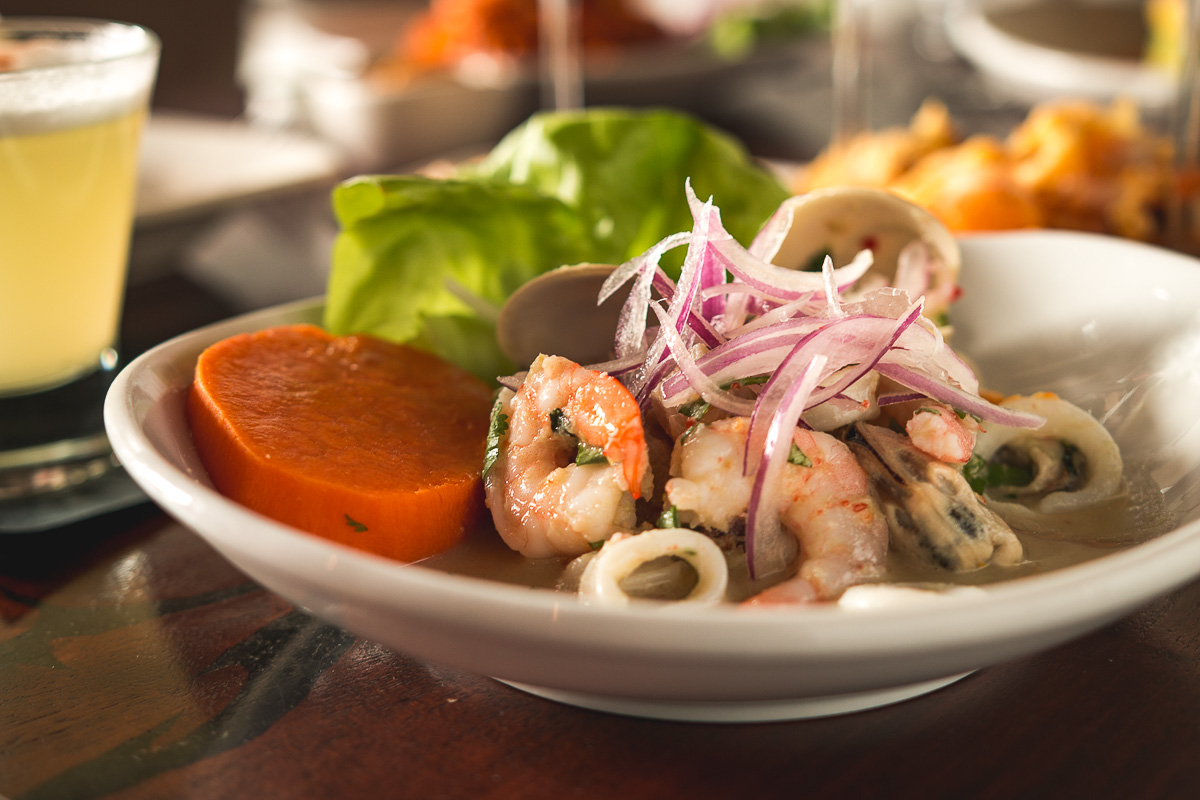
The Pescado is presented in three separate martini-style glasses, each with mahi-mahi base but marinated in separate, quite different — delightfully flavored and brightly colored — cream sauces: one with aji amarillo (a yellow pepper), another with rocoto (a red chili), and the third with yet another distinct, moderately hot Peruvian chili pepper, aji limo. Served with an assortment of crispy, fried seafood, the platter is a treat to both the eyes and taste buds.
Ceviche Mixto Clasico is one of the most frequently ordered dishes at Villa Peru — for good reason. Served in handsome, white, elongated ceramic bowls, this specialty is a rich assembly of multiple seafood varieties marinated in a sublimely balanced leche de tigre sauce. The mix of fruit de la mer typically includes mahi-mahi, octopus, shrimp, calamari, mussels, and clams, although the variety varies based on the freshest seafood available.
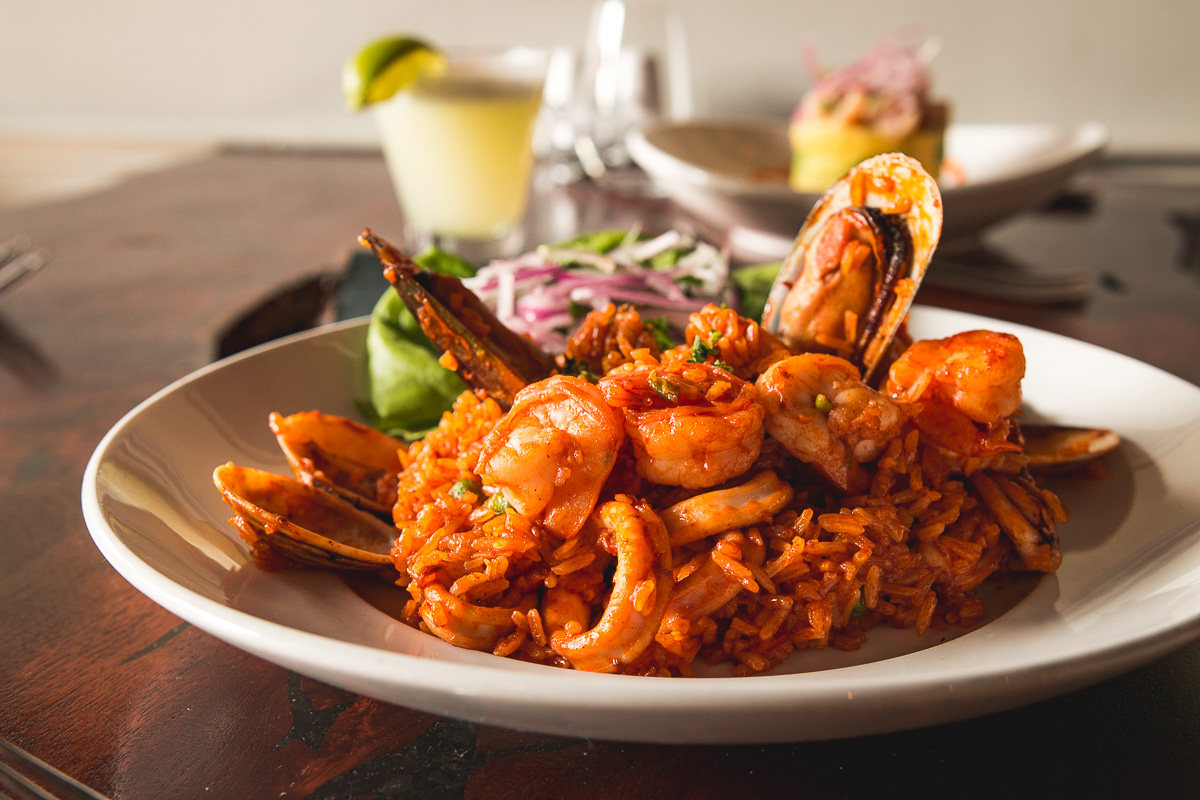
All Villa Peru dishes are made to order, so particular seafood requests are welcome and honored if possible.
Another of the restaurant’s most popular seafood entrées is Arroz con Mariscos, a paella specialty quite unlike that found anywhere else. A generous selection of fresh fish (usually shrimp, calamari, octopus, clams, and mussels) is served over rice gently cooked in a sofrito puree of tomatoes, peppers, cilantro, onions, and garlic. Added for refreshing zest is a Peruvian pepper and lime salsa — called criolla — ushering a seafood epicurean into the equivalent of culinary heaven.
For patrons preferring an alternative to fish, Villa Peru’s kitchen offers a bountiful selection of meat (chicken, beef, lamb, pork), plus salads and vegetarian options. “We take pride in serving the highest quality, organic food available,” Frida Hunt proudly explained.
The restaurant’s Lomo Saltado is a special delight: Angus beef tenderloin, stir-fried with onions and tomatoes and flavored with a light, gluten-free soy sauce (evidence of the considerable Asian influence on Peruvian cuisine). The dish is served alongside a fanciful, mini-Inca pyramid of white garlic rice and a side of plump, crisp Yukon Gold fries.
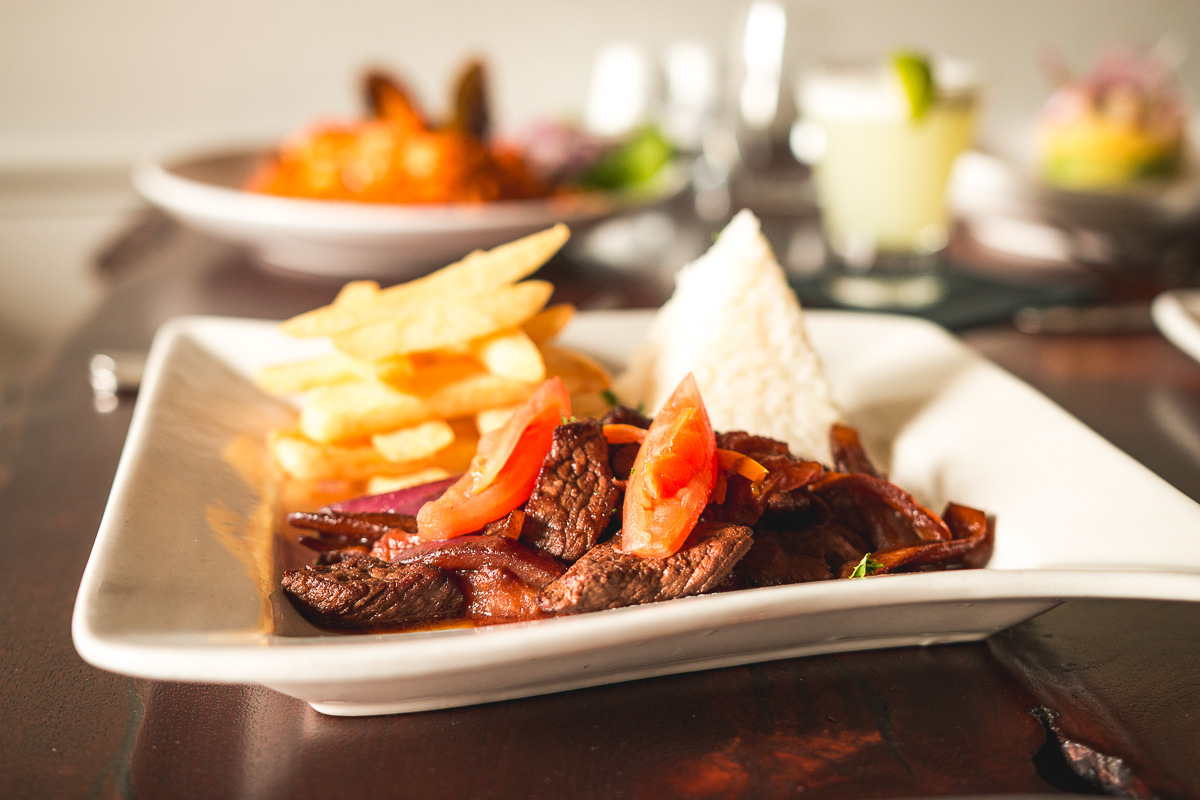
Those of us North Americans, accustomed to a usual selection of white, red, sweet, or russet potatoes, may be surprised to learn that there are 4,000 — yes, that really is four thousand — varieties of potatoes native to and grown in Peru. In fact, culinary historians believe that the world’s first domesticated potatoes originated in an extensive geographic region — most of which is now under the Peru flag — as long as 10,000 years ago.
Native Andean highland spuds come in virtually every shape, color, and taste imaginable, and traditional Peruvian restaurants worldwide, like Villa Peru, painstakingly import a myriad of varieties from the homeland.
Peru is often called the home of fusion cuisine — less because of the merger of multiple national cuisines by experimental chefs like Wolfgang Puck or the legendary Richard Wing, who combined French and Asian food ingredients — than by a natural, centuries-long integration of many cultural components.
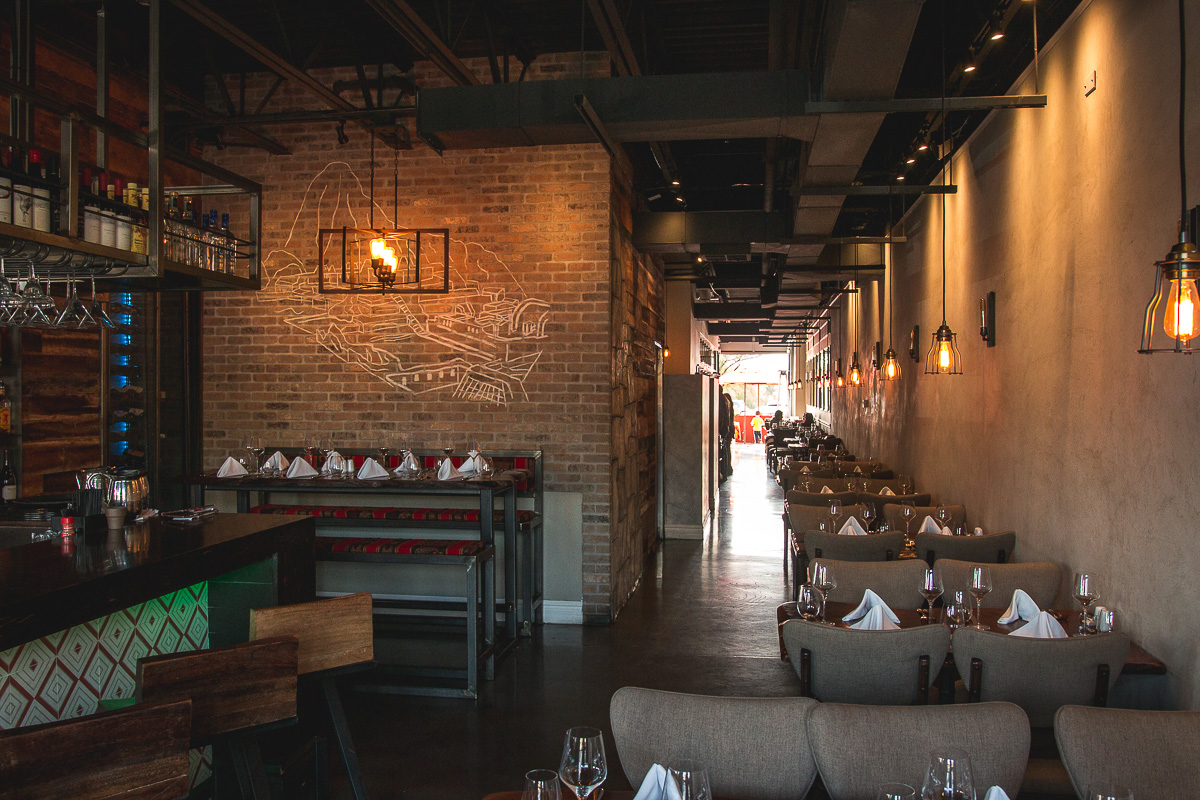
Peruvian food evolved over hundreds of years, starting with ingredients farmed or gathered by Incas and other indigenous people — including potatoes, corn, and chilies, and, of course, fish. Added to these natural staples were substantial ingredients introduced by Spanish conquistadors and other European explorers, and later, from those arriving from Africa and Asia.
These culinary building blocks accumulated through the centuries to create what is a singularly remarkable national cuisine.
The menu at Villa Peru reflects this culinary synthesis. It is extensive, running a full six pages, and eclectic. When asked whether the restaurant’s food is entirely authentic Peruvian or, at least in part, an Americanization of what one might find in a fine dining room in Lima, Chef Salazar, himself born in a remote region of the majestic Andes mountains, is quick to reply, “¡La cosa real!” — it is the “real thing.”
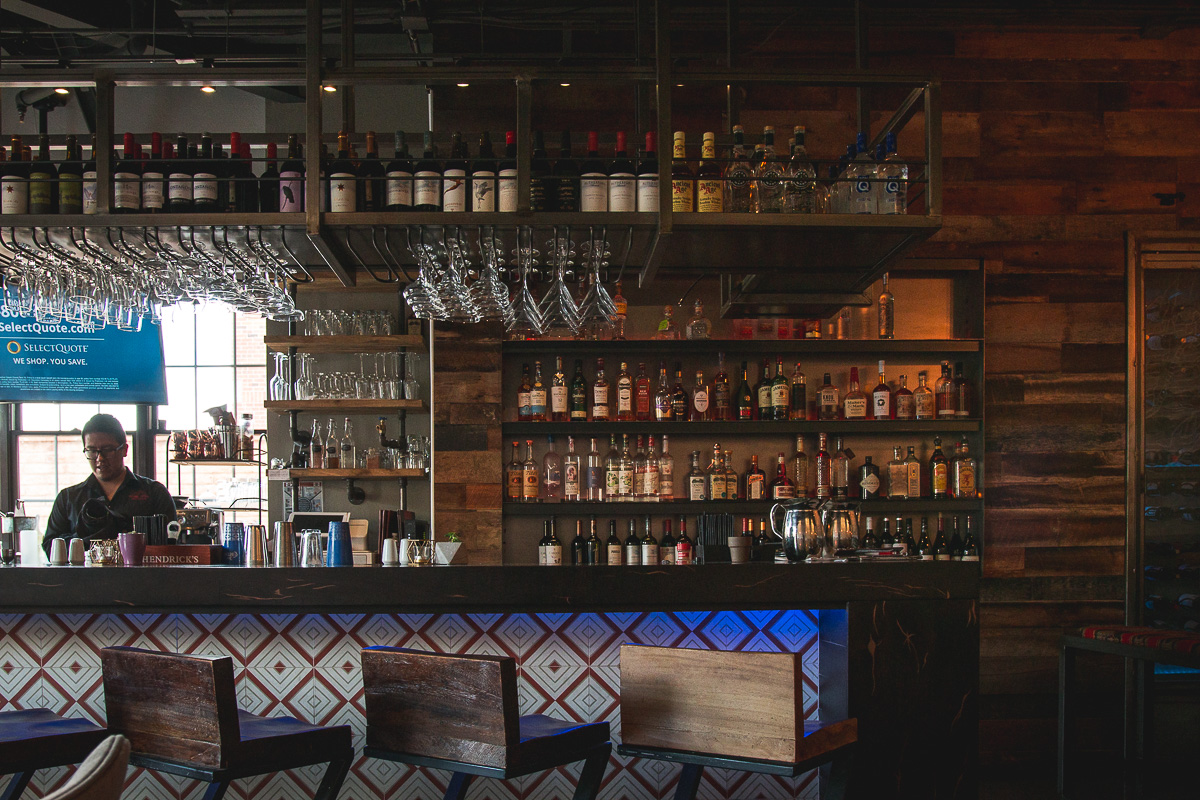
Guests, whether new to the restaurant or already South American food aficionados, offer up pisco sour toasts to internationally-acclaimed Peruvian cuisine on our very own doorstep.
Villa Peru is located at 1745 E. River Rd., Ste. 165 in Joesler Village. It’s open from 11 a.m. – 9 p.m., Monday through Thursday, and 11 a.m. – 10 p.m., Friday and Saturday.
For more information, call (520) 900-7310 or visit villaperutucson.com.